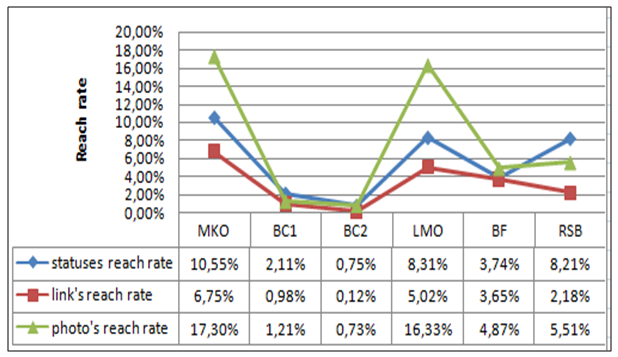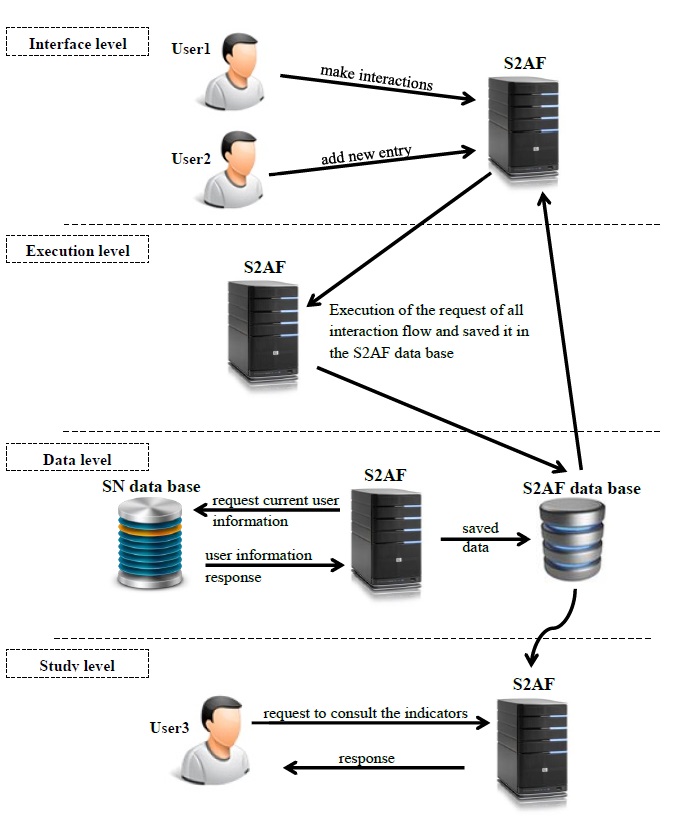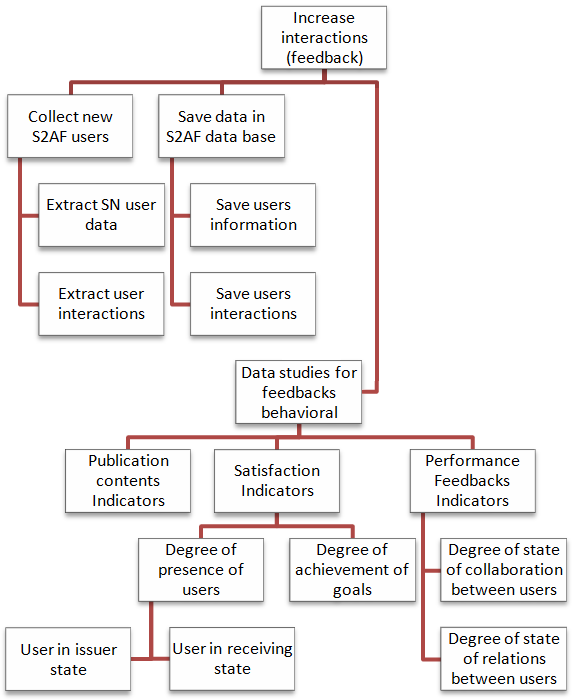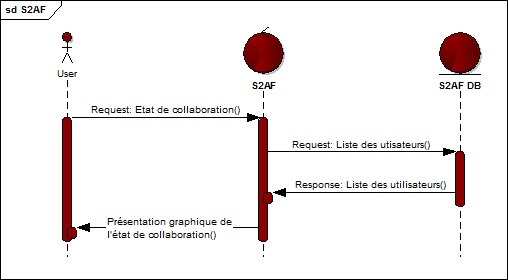-
Paper Information
- Paper Submission
-
Journal Information
- About This Journal
- Editorial Board
- Current Issue
- Archive
- Author Guidelines
- Contact Us
American Journal of Intelligent Systems
p-ISSN: 2165-8978 e-ISSN: 2165-8994
2015; 5(2): 58-63
doi:10.5923/j.ajis.20150502.02
Social Networks: Toward an Intelligent System for Increasing the Feedbacks with a Collaborative Work Way
Mohcine Kodad1, El Miloud Jaara1, Mohammed Erramdani2
1Computer Science Research Laboratory (LARI), University Mohammed First, Oujda, Morocco
2High School of Technology Team (ESTO), University Mohammed First, Oujda, Morocco
Correspondence to: Mohcine Kodad, Computer Science Research Laboratory (LARI), University Mohammed First, Oujda, Morocco.
| Email: |  |
Copyright © 2015 Scientific & Academic Publishing. All Rights Reserved.
This article's aim is to put forward a system allowing the increase of feedbacks in social networks, by using collaborative concept in an effective, credible and transparent way. Furthermore, we show our system's architecture, indicators that calculate with a presentation several of social networks websites, their classifications, its major mechanisms, the strategy opted by each one of them and its different publications' types.
Keywords: Social networks, Increase of feedbacks, S2AF, Collaborative work
Cite this paper: Mohcine Kodad, El Miloud Jaara, Mohammed Erramdani, Social Networks: Toward an Intelligent System for Increasing the Feedbacks with a Collaborative Work Way, American Journal of Intelligent Systems, Vol. 5 No. 2, 2015, pp. 58-63. doi: 10.5923/j.ajis.20150502.02.
Article Outline
1. Introduction
- Nowadays, social networks are used everywhere: at home, at school, at work and in different platforms, including those of phone mobiles and tablets. These networks play indeed a salient role in every single individual's life. According to the famous website that publishes statistics about internet "Alexa Internet", Facebook remains the leader of all social networks and the second website and the most visited website after Google. Indeed, Facebook offers three types of services, as "personal profiles"," Facebook pages" and "groups " [9].We can say that a social network is a combination of individuals and organizations that interact regularly in social interactions. It can also offer to its members the possibility to better their own social network whether it is professional or personal. However, the destined structures to create it can be voluntarily. Through these means of social communication individuals or groups can create series of web content, organize this latter, modify it or comment it. Social networks exploit the collective intelligence in an online collaboration spirit.However, the social networks use several technics and methods, such as RSS flows and other flows of web syndication, microblogging websites (Twitter), photos sharing (Flickr et Instagram), video sharing (YouTube), organizing and sharing, the collaborative bookmarking, mashups, virtual worlds, e-marketing and so on and so forth.Our contribution is to set up a system for increase feedbacks and interactions between users and social networks members' by using collective's notion in an effective, credible and transparent way. In this article, we are starting out by showing S2AF architecture and also some indicators calculated by our system with a clear presentation of some social networks websites, their classification internationally and classification by some countries (USA, China, India and Russia). After that, we spot the light on the main social networks mechanisms, the strategy opted by each of them, and showing some publications' types that these networks offer.The rest of this paper is structured as follows: In the second section we are shedding the light on the social networks with their classification and their different structures. The third section tackles social networks problems. The fourth section presents the S2AF system, its architecture with the important indicators that can be calculated. As for the fifth section, it presents the S2AF implementation. We end up with a conclusion in the sixth section.
2. Social Networks: Communication Tools
- Social networks are indispensable communication tools. They play a crucial role in each single individual's life and in companies as well. Thanks to these networks and their massive potentials, communication and collaboration between organizations have become easier.
2.1. Social Networks: Classification
- According to the major web references such as "Alexa Internet " which is the most famous website to offer statistics on the global web traffic [1], we could classify tens of social network websites depending on visitors' number. It's about a study speaking about our future objectives. Here is a table showing the ten first social networks in the world, extracted from a survey we have been working for from 02/03/2015 to 09/03/2015 (see table 1).
|
2.2. Structuring by Type of Mechanism
- The mechanisms are different depending on the strategy of each social network, for example we found:- Facebook: Likes, Followers, Shares and Comments.- Youtube: Likes, Subscribers, Comments and Views.- Twitter: Followers, Retweets and Favorites.- Instagram: Followers, Likes and Comments.- Google plus: Shares and Circles.- VKontakte: Followers and Joins.- MySpace: Connections.- StumbleUpon: Followers.- SoundCloud: Followers, Likes and Listening.- Pinterest: Likes, Repins and Followers.Et autre…Back to Facebook since it is the first on an international scale in terms of membership that exceeds 1.39 billion active users worldwide, and in terms of the number of daily visitors and according to SryFB2014 survey [8], we can extract what follows:- Facebook Shares:Facebook Shares is a mechanism that allows sharing the post and making it visible to all our friends and fans as well, taking into consideration the post confidentiality. This latter appears automatically in fans' or friends' news feed. According to a survey above we have done only 21% of facebook members' feel like sharing their posts [8].- Facebook Likes:Facebook Likes is a Facebook mechanism by which one expresses his admiration toward a post. However, it has the same role as sharing. To explain, once click on "Like", it will automatically be launched in friends' news feed that their friend X clicked on "Like" on a post Y. According to survey above, 34% of Facebook users' wish having "Likes" on their posts [8].- Facebook Comments:Facebook Comments is a mechanism that enables Facebook users' to express their minds, whether by posting a text, an image or even a link. It will automatically be launched in friends' news feed that their friend X has commented a post Y and this surely depends on the post's confidentiality. According to the survey above, the "Comment" is the most desired mechanism: 45% of Facebook users' feel like having comments on their posts [8].
2.3. Structuring by Category of Publications
- Each social network offers these types of publication, if we take Twitter, it offers "tweets". Instagram offers "picture" and "video". YouTube offers one type is "video". Facebook offers three type of publication "Link", "Status" and "Photo". Etc..Going back to the social network Facebook, that is the subject of our case study, and according to the survey done in SryFB2014 satisfaction study [8], we can summarize the types of publication as:- Facebook Link:The link is a type of facebook posts that is rated third in the classification of the most used patterns of posts by facebook users with 27% according to the survey above. This pattern of posting on facebook collects the URL addresses internal or external that are shared or sent via private messages. Facebook considers the videos as external links as well [8].- Facebook Statuts:It is a type of post facebook, ranked in 2nd position after the type "photo" with 36% according to the survey above, but not a lot of differences with the category "Photo" as the rate of sharing implies, this type of post brings everything that sharing or exchange on facebook but with only text, this type is often used to express [8].- Facebook Photo:The photo is a sharing pattern the most used on facebook. It is rated in the first position with 37% according to the survey above this type of posts collects images and videos shared on facebook [8].
3. Problems
- Several studies are done into the field of social networks, some of them have unveiled some problems either theoretical or technical, and if we take Facebook as a study case wich is the most visited social network in the world, speaking of his functionalities, this social network offers "pages", "profiles", "groups", and as for the profiles, you can customize the pages by publishing news, organizing events, adding applications, etc. People who like your page and their friends can receive updates in the News Feed [9]. A which is a bit contradictory to statements Facebook recently released, especially ther one with the title "Generating Business Results on Facebook", we can read as follows: « But content that is eligible to be shown in News Feed is increasing at a faster rate than people’s ability to consume it... People are connecting to more Pages and individuals every day… But to maximize delivery of your message in News Feed, your brand should consider using paid distribution, as it enables you to reach people beyond your fan base and move beyond the organic competition. » [10]. So we can conclude from this statement that if we want our posts on facebook page are seen in the news feed of users, we have to pay.Also according to what was done in [8] whether in the SryFB2014 survey or in the experimentation, it can be deduced that there is a big dissatisfaction of Facebook users about the interactions to their publications, and this experiment revealed the common responsibility of the strategy made by the user and Facebook itself including:- The results of SryFB2014 say that only 11% of Facebook users are satisfied interactions made for their publications, 22% say "A Little" on the other side a large number that represents 67% of the respondents said "NO", which means that they are not satisfied.- The Fig.1 shows some tests done in this work, which allows us to conclude the following: More the Facebook pages get fans fewer reach rates gets, The "Photo" type is the best post in term of reach rate, The "Link" type is the lowest post in term of reach rate, and More the number of feedback increases more the reach rate increases (eg. RSB page).
 | Figure 1. The reach rate for each facebook page in all types |
 R: Reach RateN: Reach NumberF: Fan Number
R: Reach RateN: Reach NumberF: Fan Number4. S2AF System
4.1. S2AF: Architecture & Overview
- The S2AF system (its abbreviation comes from the French language system for Aid to Increase Feedbacks in social networks) that we propose is a system that aims to solve some problem in "3. Problems" and also to help users main goal of social networks to increase the interaction and feedback to its shares either its publications, pages or other ... with the use of the term in order to increase community satisfaction overall against the various mechanisms presented in section 2.2.The evaluation of user interactions based on the results provided by the indicator automatic interaction analysis offered by the system. In addition, it offers an open architecture that will fit the types of environmental indicators of satisfaction. To help achieve these goals, we have opted for a n-tier architecture. Referral to n-tier architecture was driven by several aspects. Indeed, in such a system, many subscribers can access the database that made it vulnerable, suddenly with a multi-tier access to basic architecture is only performed by the application server, it is possible to manage security at the application server, for example by maintaining a list of users with their passwords and their access rights to system functions without changing the overall structure.Thus, we propose an architecture with four levels (see Figure 2).
 | Figure 2. S2AF system architecture |
4.2. Indicators Calculated by S2AF
- The indicators calculated by our system are divided into three categories: publications contents indicators, satisfaction indicators and feedbacks performance indicators. The data extracted by S2AF for this calculation are those related to the user identification as (login, name, email address...), with its interactions as (like, share, comment ...) and its different publications as (picture, link, or status).- Publication Contents Indicators:The publication contents indicators show information about types of publications and social network use. These indicators relate to the interactions of users related to the task and content of the activity carried out. - Satisfaction Indicators:These indicators refer to satisfaction with interactions and collaborations realized. Among the indicators that have a high interpretation value, we can note those who provide a state of satisfaction with the goals, while calculating the degree of user presence on S2AF interface whether the issuer state or to the receiving state.- Performance Feedbacks Indicators:These indicators refer to modes or quality of feedback and collaboration. Among the indicators that have a high interpretation value, we can note those who realize the quality of collaboration during interactions those and who provide state of relations established between users.About the choice of indicators calculated by our S2AF system, we have adopted an incremental approach; we first determine some indicators in order to test the architecture of our system, and as needed we can integrate other indicators that stakeholders (user, administrator and webmaster) consider relevant. The Figure 3 shows the hierarchical diagram of all goals of S2AF system and integrated indicators.
 | Figure 3. Hierarchical diagram of the S2AF goals |
5. S2AF: Implementation
- For the development and specification of our S2AF we used the 2TUP process (2 tracks unified process), it belongs to the category of processes that meets the requirements of unified process. The 2TUP process provides a response to continual change constraints required on information systems. In this sense, it strengthens the control on the evolution capacity and on the correction to this system. The « 2 Tracks » literally mean that the process follows two paths. We talk about the « functional paths » and the « technical architecture», which correspond to two change axes required to the information system.Regarding to the technological aspect, our choice fell on PHP5 for several reasons: is a general scripting language and Open Source, well documented, updated periodically, and also adheres to international standards and designed specifically for the development of web applications. The large advantage is that PHP extremely simple for a newcomer, but offers advanced features for experts.We have defined several use cases, according to the task that the system is required to achieve. We present below an example of a sequence diagram relating to the use case of the indicator of feedbacks performance; "state of collaboration between users" (see Figure 4).
 | Figure 4. Sequence diagram providing Performance Feedbacks Indicators: the state of collaboration between users |
6. Conclusions
- On this paper, we are showing our S2AF system that is aiming, as we have seen before, to increase feedbacks in social networks, by using the community and collaboration work notion with a reliable, credible and transparent way.In this article we have seen S2AF architecture, indicators that calculate, with a presentation of the top ten social networks websites, their classifications, their main mechanisms, the strategy opted by each social network and their different publications' types.Concerning perspectives, we intend to develop a multi-agent system for the coming generations in an automatic way so as to validate the conformity of our system in case of corrections and improvements.
 Abstract
Abstract Reference
Reference Full-Text PDF
Full-Text PDF Full-text HTML
Full-text HTML